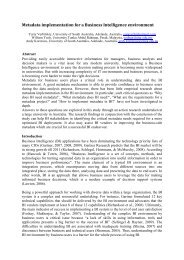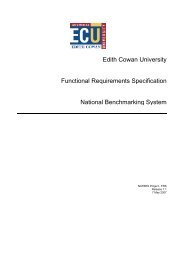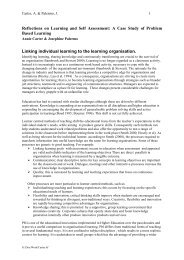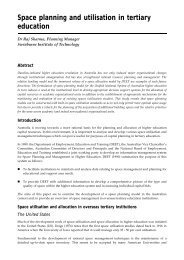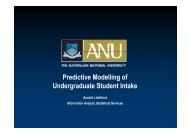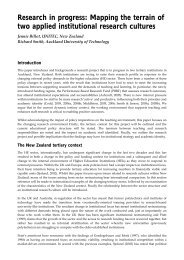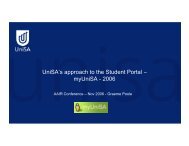Study of student costs using activity based costing methodology - aair
Study of student costs using activity based costing methodology - aair
Study of student costs using activity based costing methodology - aair
Create successful ePaper yourself
Turn your PDF publications into a flip-book with our unique Google optimized e-Paper software.
2. The cost <strong>of</strong> a <strong>student</strong> includes a fixed element and a variable cost element which is dependent upon<br />
the <strong>student</strong>’s workload (or EFTSU);<br />
3. A method <strong>of</strong> funding <strong>based</strong> entirely on EFTSUs is not a reflection <strong>of</strong> the level <strong>of</strong> expenditure required<br />
to support a diverse <strong>student</strong> population, and<br />
4. UTS, with a large part-time <strong>student</strong> population, is under funded through the Commonwealth<br />
Government Relative Funding Model which fails to address the fixed element <strong>of</strong> administration<br />
<strong>costs</strong>. 22<br />
A more appropriate funding model would recognise the following <strong>costs</strong> in a <strong>student</strong> pr<strong>of</strong>ile:<br />
• a set administration cost;<br />
• a set faculty cost<br />
• a variable faculty cost.<br />
This could be represented in the fashion <strong>of</strong> the following formula:<br />
funding = a x (<strong>student</strong> #‘s) + b x (EFTSU)<br />
where:<br />
a = the fixed cost per <strong>student</strong> for the faculty<br />
b = the variable cost per <strong>student</strong> for the faculty<br />
Clearly the fixed amount per <strong>student</strong> would vary between disciplines as would the coefficient <strong>of</strong> the<br />
variable amount.<br />
As the study <strong>of</strong> part-time <strong>student</strong> <strong>costs</strong> at UTS was the first reported application <strong>of</strong> <strong>activity</strong> <strong>based</strong> <strong>costing</strong><br />
<strong>methodology</strong> in higher education it is worthwhile reflecting on some <strong>of</strong> the limitations and difficulties<br />
experienced in the application.<br />
1. Some <strong>of</strong> the organisational units such as Student Administration and Publicity and Public Affairs were<br />
responsible for several activities and it was necessary to carry out a detailed analysis <strong>of</strong> staffing and<br />
expenditure to separate out the <strong>costs</strong> <strong>of</strong> individual activities. Sometimes staff performed more than<br />
one <strong>activity</strong> as part <strong>of</strong> their job and it was necessary to estimate the amount <strong>of</strong> time spent on<br />
individual activities. This task was time consuming.<br />
2. In the case <strong>of</strong> some cost drivers data was not readily available, for example in relation to space which<br />
was a driver for a number <strong>of</strong> overheads, such as cleaning, power, security. In these cases it was<br />
necessary to make technical estimates as a basis for allocating <strong>costs</strong>. Appropriate cost driver<br />
information was also not available for the library or for computing and technical estimates were<br />
necessary in these areas.<br />
3. Another difficulty arose from the fact that in the first year <strong>of</strong> amalgamation the organisational<br />
structure for a number <strong>of</strong> administrative areas had not been finalised and there was some duplication<br />
<strong>of</strong> <strong>costs</strong> between old UTS and Kuring-gai.<br />
4. In a broader application <strong>of</strong> the <strong>methodology</strong>, particularly for comparative purposes, it would be<br />
necessary to recognise a potential problem may arise from individual differences between one<br />
university and another in the treatment <strong>of</strong> certain administrative activities. For example, at UTS,<br />
careers and appointments activities are carried out by the Union, whereas at many universities these<br />
<strong>costs</strong> are met by the university administration.<br />
22 Ibid., p. 14.



